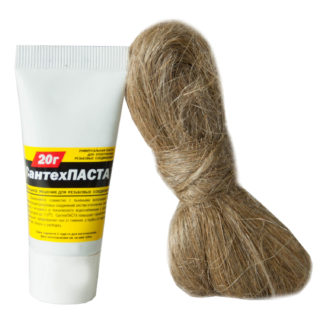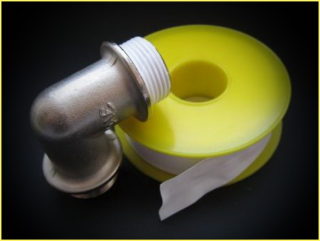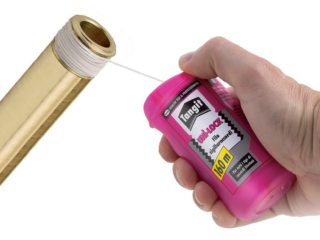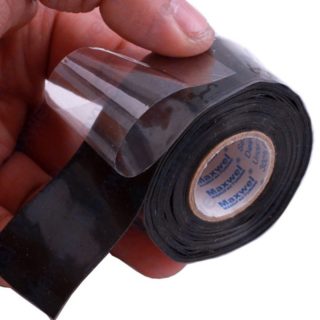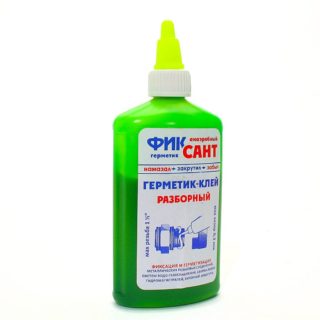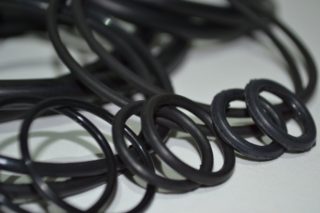The variety of products for sealing in the distribution network is so great that buyers sometimes can not choose the better to seal the threads on the water pipe during repair. However, there is no universal seal, you need to understand which of the materials will be more suitable in a particular situation.
Linen Sealer
To process flax, they use plumbing, otherwise it will decay and crumble on a hot water supply pipe (hot water supply), and it will decay on a cold water supply (cold water supply). The threaded water connection of the paste treated with paste is allowed to be adjusted (corrected by turning back) to an angle of up to 45 °, parts are easier to wind up, the thread is protected against corrosion.
Advantages:
- the lowest price;
- thread of all sizes is sealed with linen;
- the surface is suitable in any condition: dirty, wet, rusty, with damage.
Disadvantages:
- it is difficult and long to work with linen sealant;
- hands, pipes and tools are always dirty from flax and paste fibers;
- when tightening and swelling creates stresses in the thread.
Flax is good for sealing the connection of metal pipes and fittings, but work with thin-walled parts and small threads carefully. Of the combined elements, it is better to take those in which the plastic part is made of more flexible polypropylene.
It is impossible to seal the joints of parts made entirely of plastic with linen - because of the large tightening torque, wall damage and thread breakage are possible.
FUM tape
The advantages of PTFE sealing material:
- soft, parts are easily twisted and easily turned away, you can not be afraid of tearing or cutting new threads with metal through plastic due to the strong seal;
- the cleanliness of the threaded surface does not matter;
- almost does not get dirty.
Disadvantages:
- even with a slight displacement of the connection, leakage is possible;
- if it is improperly twisted, it is impossible to align the thread with the feed back, an attempt will lead to leakage, the connection can only be disassembled and reassembled with re-winding the tape.
For beginners, FUM tape for sealing water pipes creates the most problems. It is advisable to use it in temporary engineering systems or where a slight leakage is not critical, for example, in a country water supply.
For sealing fit parts of any material with medium-sized threads in good condition. The material is safe when sealing thin-walled fittings. It is contraindicated to seal the thread on the water pipe with tape with possible shifts, in the area of impact loads or vibration.
Plumbing thread
Consists of silicone coated polyamide microfibers. Very durable, impossible to tear with your hands.
Benefits:
- equally well seals any thread: old, with corrosion, wet, damaged;
- after sealing, adjustment to an angle of up to 180 ° is possible;
- the tightening torque is less than when using flax, it is easy to assemble and disassemble;
- less fum tape gets dirty.
Disadvantage: several times more expensive than flax, at a price comparable to FUM tape.
Even a layman can work with a thread, technically it is the simplest sealant. It can be used without restrictions on all types of joints, it is especially convenient for threading with a fine pitch. For plastic parts, the thread must be used carefully.
Silicone tape
Combines the advantages of these materials. It differs from FUM tape for the better in its resistance to vibrations and the ability to align to an angle of up to 180 °.
Disadvantages:
- can not be used on narrow and thin threads;
- costs much more than a thread and FUM tape.
It is recommended to use silicone tape for sealing water pipes and fittings made of metal and plastic with large threads.
Anaerobic Sealant Adhesive
The last generation sealant hardens only after twisting, hardens within 20 minutes.
The viscosity, hardening rate, and fixing strength of the compositions are different. The thinner the glue, the smaller the thread it is designed for. A connection mounted with a strong-fixation anaerobic sealant is disassembled only when heated.
- the fastest installation;
- going without keys, with one hand;
- fills all inter-threaded space;
- when twisting, there is no skew, the load on the thread is transmitted evenly;
- prior to setting, adjustment to any angle is possible;
- the connection does not have to be reached, as is the case with flax, ribbons or thread;
- no protruding parts of the seal;
- protects against corrosion;
- resistance to high water pressure.
Disadvantages:
- the most expensive sealant;
- the junction should be perfectly clean and fat free;
- You can use the water supply only after the sealant has cured;
- complex disassembly of the connection;
- after heating during dismantling at the junction of dissimilar materials, a leak may occur;
- get your hands dirty.
It is used to assemble new threaded joints made without the use of lubricant. Anaerobic sealant for water pipes is convenient when installing joints in hard to reach places. Given the complexity of disassembly, it is better to use for nodes that are not planned to be disassembled.
Cold welding
 Plasticine two-component composition based on epoxy resin when connecting both parts turns into the strongest glue.
Plasticine two-component composition based on epoxy resin when connecting both parts turns into the strongest glue.
Benefits:
- some types of cold welding are allowed to be applied on a damp surface and under water;
- the resulting mass can be given the desired shape and processed after solidification.
The disadvantage is the high price.
Cold welding is indispensable when it is necessary to eliminate a leak, but there is no time for disassembly or the possibility of blocking the water supply. Usually this decision is temporary.
Cold welding can restore threads or breakaway parts. It is enough to apply the mass to the damaged place, screw it on, and then unscrew the joined element and wait for curing.
Seals and rings
They are used if one of the parts has a restrictive collar against which the end face of the second rests. A gasket is placed between the contacting surfaces if the flange is internal, and the ring if external. Sealing the thread is not required, on the contrary, this is considered a mistake.
It is better to use rings and gaskets made of soft silicone for cold water, and in the hot water system put gaskets made of heat-resistant rubber or paronite.
The advantage is the speed of installation: just install the gasket or put on the ring and tighten. Disadvantage: due to the requirement for the presence of a shoulder, they are used in a narrow segment.
Rings and gaskets seal the joints when installing fittings and hoses with a union nut, crane boxes in mixers.
None of the materials examined can replace all the others. It is always best to keep a set of several gaskets on hand and use them, depending on the situation.
